Tuesday August 8 - Another travel day. It was a gray, rainy day as we packed the van and made one final sweep of the cottage. We left a note for Judy, to thank her for a great vacation experience. We were on the road early -- before 0900, I think.
The rain intensified as we headed south. We also began encountering large RV's on the road, apparently traveling as a group, each one towing a smaller SUV. For the first part of the drive, RV's on the road would be a frequent encounter each hour.
Breakfast was at Tim Horton's (a consistent culinary theme on this holiday) in Deer Lake, and then we began the long eastward trek to retrace our steps on the Trans Canada. By mid to late morning, we had gotten out from under the weather front -- ahead were gray skies that were getting progressively lighter. The dark clouds were behind us.
We made Gander by early afternoon, and again for reasons similar to the first occasion, had a return bout with lunch at Jungle Jim's. Having done the drive in the other direction, we now had some sense of the magnitude of the trip, so we decided to spend some time in Gander. And in Gander, where else but at the Aviation Museum would tourists go? It helped that the Museum was just across the highway from the restaurant.

Parked on the lot, off to the side of the building, we saw an ex-Canadian Air Force CF-101 Voodoo -- a 1950s vintage interceptor, replaced by the CF-104 Starfighter, which in turn was replaced by the current generation CF-18 Hornet. There were other aircraft parked outside the building. When we got inside, we found one of the exhibits to be a DC3 cockpit replica, done by grafting the forward section of a DC3 fuselage, including the cockpit area, onto the back of the building. There were many other models, exhibits, and displays in the museum, which appeared to be a converted warehouse.

Corwin and Cameron found airplane toys. Robin found interesting places to crawl into and hide. The photo above shows Corwin beside a Tiger Moth biplane.
We also found some computing history -- an old PDP-11 computer -- as large as a wardrobe cabinet, with much higher power demands than fridge, and not a lot of computing power in today's terms. The sign beside the PDP-11 indicated that it had been in service at the Gander airport for over twenty years, and retired in the early 2000's. The hardware had been obsolete when it was brought into service!
Among the exhibits, there was a plaque for No. 10 Bomber Reconnaissance Squadron, as follows:
No. 10 Bomber Reconnaissance Squadron (10BR), known officially during WWII as "The North Atlantic Squadron", was originally formed at RCAF Station Trenton, Ontario, in June 1937. During the next two years, it was stationed at Ottawa, and the Calgary, where it remained only until August 1939, when it was moved to Dartmouth, Nova Scotia.
Mobilized on September 10th, 1939, and equipped with Douglas Digby B-18 (DC-2 Bolo) aircraft, 10BR conducted anti-submarine and coastal patrols from Dartmouth until June 1940, when "A" flight moved to Gander and the remainder of the Squadron joined it shortly afterward. It continued to use the Digbys for three years until they were replaced by Lockheed Liberator (B-24) aircraft in April 1943.
10BR Squadron established a record with attacks on 22 U-boats, including 3 sinkings. During the war, it flew 3414 sorties and lost 7 aircraft, with casualties of 24 crew. It moved to RCAF Station Torbay in June 1945 and was disbanded on August 15th, 1945.
Researched by William Sullivan, Gander
The stop in Gander was a nice break. We continued eastward by mid-afternoon, crossing onto the Avalon Peninsula and passing the first turnoff for Cape St. Mary's just before sunset.
It was dark when we got to the hotel. We got the children settled with Liza, and then Chris, Jill, and I went back out with a luggage cart to complete the unloading of the van. Toward the end of loading the cart, we were all distracted by the task of climbing in the van, putting the middle seat back up, and looking under all the seats to see whether there was anything that small hands had dropped. Moments later, when we finished and looked up for the luggage cart, it had vanished, apparently into thin air. Further searching revealed it across the street -- it had rolled, soundlessly, across the gently sloped parking lot, down the sloping curved driveway, and across the street -- without hitting any other car, or spilling any luggage, or causing an accident with oncoming traffic.
Dinner that night was take-out Chinese food from the Magic Wok. We packed the children in one room in front of the tube, and had a blessedly civilized adult dinner and conversation in the other.
Wednesday August 9 - Back to Signal Hill. And this time, we got in to the Cabot Tower, although it closed (again due to wind) during our visit.
We went down to the Visitor Centre, and left the van there while we made the short hike to the Queen's Battery.

It was obvious why the site had been selected -- from this vantage point, the cannons of the coastal battery had a commanding view of the Narrows. It was not too difficult to conclude that any halfway capable gunnery officer with competent gun crews would be able to place a shot onto any spot inward of the Narrows -- a sobering prospect for any admiral leading an invasion fleet which, of course, would have needed to sail through the Narrows and past the Queen's Battery.


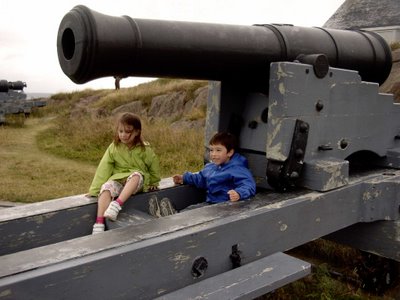
The cannons made a great playground for the children. However, with complete disregard for their historical significance, my son sat on one of the carriages, with the cannon looming over his head, and pretended that he was piloting a Star Wars hovertank in the Clone Wars.
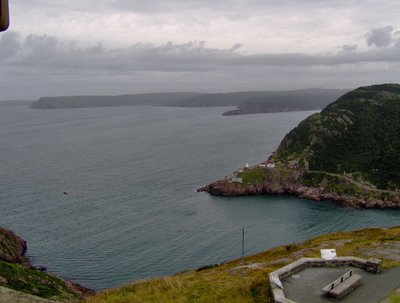
From the Queen's Battery, Fort Amherst, on the other side of the Narrows, was much more clearly visible than from the top of Signal Hill. (A day without fog, and zoom settings maxed on the camera didn't hurt, either). We drove around the harbour to the other side for a first hand look.
Fort Amherst was built in 1777. There is nothing left of the original fort, although there are crumbling World War 2 concrete bunkers and an old lighthouse. The road leading to the fort is also the location of private houses, all nestled on the rocky slope beside the road.


Two views of the Narrows above from the Fort Amherst side: without a ship passing through to show the passage, and with a ship to show how narrow the passage actually is.
In the photo, the ship was (we think) a supply vessel from one of the offshore drilling platforms. But many ships going far back into history have sailed into the harbour through the Narrows. Make the ship gray and longer and put guns and depth-charge launchers on it -- a World War 2 Canadian corvette returning from mid-Atlantic convoy escort duty. Make it a three masted schooner or man-o-war -- the ship of Captain James Cook arriving in the Colony of Newfoundland, a stop enroute to the Caribbean or to points farther south beyond the equator.


Thursday August 10 - Our last full day in Newfoundland. If we were to make it to Cape St. Mary's, today would be the day. This proposal was vetoed on the grounds that hours of driving (about two and a half to three hours each way) would not be good for the kids. A second independent survey conducted with Corwin confirmed this view.
Seeing Cape St. Mary's again was one of my personal objectives for this trip, and I didn't want to give it up that easily. After a quick discussion with Jill, I went through the Yellow Pages and called every car rental company (including Rent A Wreck) in St. John's to see if I could rent a car for the day, and at least go myself. To my surprise, horror, and disgust, no one -- no one! -- had anything available. I did find a bus service that would get me to St. Bride's, close to Cape St. Mary's, but I was unclear on whether the bus service included a return trip the same day.
Having exhausted all options, I regretfully bowed to the inevitable.

A walk through downtown St. John's, lunch, and a trip to the railroad museum was the order of the day.

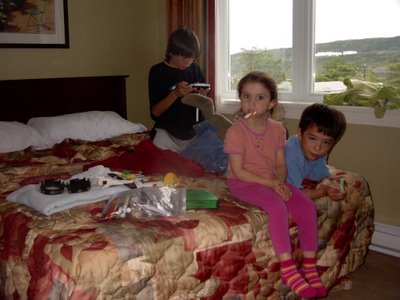
That afternoon, I looked after Corwin, Robin, and Cameron while Jill, Liza, and Chris did some shopping along Water Street. While they were gone, Erin and a friend dropped by, to bring us back our shipping box which they had kindly taken away and stored for us for the last week.
That afternoon, both Jill and I, and Chris and Liza, went through the exercise of packing away books and clothing and miscellania in two shipping boxes (Jill went out to get a second one). Late afternoon, one box (the one which had been mailed here originally) was taken to the post office and mailed. The second would be part of our checked luggage going back.
Around the same time, I discovered that I had left two books behind in Norris Point, so I e-mailed Judy from the hotel to ask her to look for them.
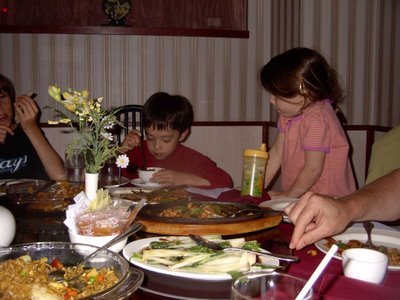
Our last dinner in Newfoundland was at the Magic Wok (decided through a best out of three coin toss -- the other possibility was the Keg).
Friday August 11 - The morning of our departure was sunny, with a light scattering of clouds. After breakfast in the hotel, we loaded the van and checked out. From Le Marchant Street, we went down to Water Street, passing an EU Fisheries Patrol vessel called Jean Charcot tied up at the pier.



When I worked here in '97, my tradition was to go up to the top of Signal Hill every time I left for the airport, and start my trip home from there. I was happy that this tradition would continue. Early morning, at the top of Signal Hill, the combination of sea, sky, and sunlight was very peaceful.
We did something new that morning -- we climbed down the stairs on the seaward side of the Cabot Tower -- over a hundred of them, down a very steep slope. From there, we walked out to where the soil and ground cover ended and there was only bare rock.


Here, we paused for a few minutes to enjoy the sun and the water, and to reflect on what a great vacation it had been.
It was a long climb back up to the parking lot -- over a hundred stair steps, but this time we were climbing up. Robin had to be carried for the last half. I deeply envied her.
We delayed in downtown St. John's for a few minutes longer, reluctant to leave. We took some more photos -- of houses, of the NewTel office facility behind the Hotel Newfoundland, of the harbour. Eventually we made our way to the airport.
We unpacked the van onto two airport luggage carts. I returned the van to the car rental compound, dealt with the paperwork, and went in search of my family, duly finding them in the Air Transat check-in lineup.
The previous day, there had been a security incident in the UK. The consequence of this incident was that the transport authorities were not allowing liquids to be carried on board aircraft. As a result, Jill had to give up her eyedrops and lipstick. Liza had to give up Robin's anti-histamine medication. After we cleared security, Jill and Corwin and I were called back, because they were concerned about the individually blister packed Gravol pills in Jill's purse. (They let us carry them through). For our group, these measures were a minor annoyance, but I understood that the were massive delays in the air transport system over the next few days.
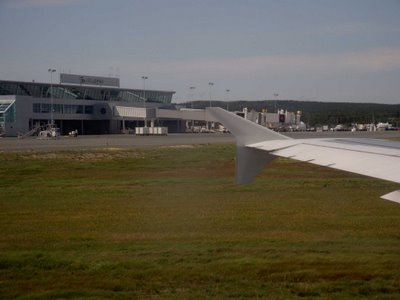
It was also clear that these measures also equated to what security expert Bruce Schneier calls "security theatre" -- a knee-jerk response for the sake of demonstrating a response with no plan behind what goals the response was supposed to accomplish.
This became evident on the plane. One of us ordered a "tuna kit" for lunch for $5. When the flight attendant brought it, we all burst out laughing -- the tuna kit was a can of tuna salad with crackers, all packed together in one air tight package. The can opened with a pull tab that would allow the user to remove the entire metal lid. Once removed, of course, the metal lid with its sharp edge could have been converted to a much more effective weapon than all of our confiscated antihistamine, eyedrops, and lipstick put together.

After an uneventful flight home followed by a lengthy delay in getting our luggage, we arrived back home.
The memorable Newfoundland vacation was over.
Epilogue




No comments:
Post a Comment